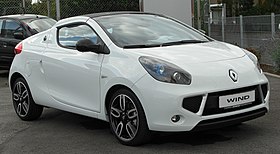| This article relies excessively on references to primary sources. Please improve this article by adding secondary or tertiary sources. Find sources: "Renault Wind" – news · newspapers · books · scholar · JSTOR (May 2010) (Learn how and when to remove this message) |
| Renault Wind | |
|---|---|
 | |
| Overview | |
| Manufacturer | Renault |
| Production | 2010–2013 |
| Assembly | Slovenia: Novo Mesto (Renault Slovenia) |
| Designer | Yas Suzuki (exterior) Johann Ory (interior) |
| Body and chassis | |
| Class | Roadster (S) |
| Body style | 2-door convertible |
| Layout | FF layout |
| Platform | Clio II |
| Related | Renault Twingo |
| Powertrain | |
| Engine | 1.2 L D4FT turbo I4 (petrol) 1.6 L K4M-RS I4 (petrol) |
| Transmission | 5-speed manual |
| Dimensions | |
| Wheelbase | 2,368 mm (93.2 in) |
| Length | 3,822 mm (150.5 in) |
| Width | 1,698 mm (66.9 in) |
| Height | 1,415 mm (55.7 in) |
| Curb weight | 1,206–1,248 kg (2,659–2,751 lb) |


The Renault Wind is a two-seater roadster by the French automobile manufacturer Renault. The Wind was originally a concept car unveiled in September 2004 at the Paris Motor Show as a 2+1 roadster. On February 2, 2010, Renault announced that the Wind would enter production. It was unveiled at the Geneva Motor Show on March 2, 2010.
Presentation
The production version is a two-seater, as opposed to the 2+1 seating of the concept car. In February 2012, Renault retired the Wind, Espace, Kangoo Multix, Modus, and Laguna lines in the United Kingdom. For Mainland Europe, the Wind remained available until June 2013. Renault bought the rights to the Ferrari Superamerica's roof, and used it on the Wind. The boot canopy was added later.
Engine
The Wind is equipped with an straight-4 petrol engine: either the 1.2 litre TCE turbocharged engine producing 100 bhp (100 PS; 75 kW), or a 1.6 litre naturally aspirated engine producing 133 bhp (135 PS; 99 kW) shared with the Twingo Renault Sport.
Design
The concept Wind's design is like other Renault vehicles such as the performance versions of the Clio and Mégane. The production Wind, however, is heavily based on the Twingo, evident in its overall size and stance, as well as its windscreen wiper mechanism, and also its semi-circular door handles exactly the same as those on the Twingo.
The steering wheel and pedal assemblies in the concept are adjustable and fold away automatically when the door is opened for easier access.
The Wind features a one piece metal roof which rotates 180° backwards (much like the 2005 Ferrari Superamerica), instead of being made of several pieces like many other metal roof convertibles. Renault claims that it takes twelve seconds to fold the roof away, which is comparable to most other convertibles.
Trim lines
There were three model trim lines: Dynamique, Dynamique S, and the limited edition "Collection". The Dynamique trim line was the most basic, with 16" alloy wheels and air conditioning as standard features.
The Dynamique S trim was above this, with 17" alloy wheels and climate control. The Limited Edition "Collection" trim had the biggest range of features, including a gloss black retractable roof and red and chrome dashboard inserts. In the United Kingdom, trim levels included: Dynamique, Dynamique S, GT Line, and the top of the range Collection.
Wind Concept

The Wind concept car was unveiled at the 2004 Paris Motor Show as a 2+1 roadster, and was powered by an inline 4 engine which produced 136 bhp (101 kW) and 141 lb·ft (191 N·m) of torque.
See also
References
- "Geneva motor show 2010: Renault Wind". Autocar. 15 February 2010. Retrieved 2 February 2014.
The Wind, which will be launched at the Geneva motor show next month, shares its platform and much of its front-end styling with the Twingo.
- "Renault Wind: A Breath of Fresh Air in the Roadster Market" (PDF). Archived from the original (PDF) on 2011-07-16. Retrieved 2010-02-02.
- "Renault to cut five UK models". telegraph.co.uk. 19 December 2011.
- "Aus und vorbei". auto-news.de. Retrieved 14 May 2015.
External links
| Renault | |||||||||||||||
|---|---|---|---|---|---|---|---|---|---|---|---|---|---|---|---|
| Current models |
|  | |||||||||||||
| Future models | |||||||||||||||
| Discontinued models |
| ||||||||||||||
| Concepts / prototypes |
| ||||||||||||||
| Historic commercial vehicles | |||||||||||||||
| Engines |
| ||||||||||||||
| Regional marques | |||||||||||||||
| Subsidiaries and joint ventures |
| ||||||||||||||
| Related | |||||||||||||||